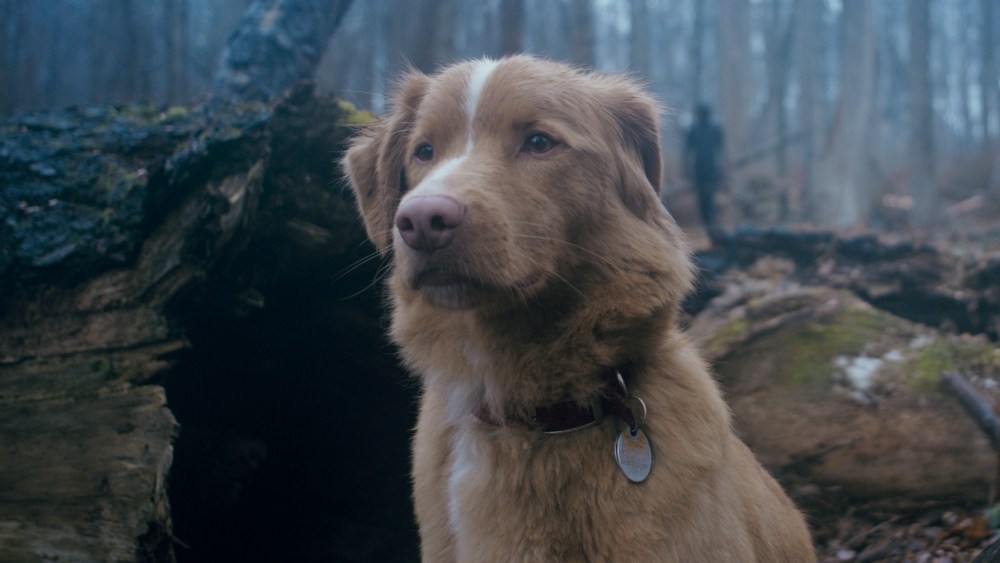At the center of Ben Leonberg’s breakout horror movie “Good Boy” is his brown and white retriever Indy, who, throughout the 80-ish minute movie, must protect his sickly owner from a sinister supernatural force. While making Indy his star drew plenty of buzz following the film’s SXSW debut, putting his canine companion in on-screen peril has incited a mixed bag of audience reactions.
“As soon as the movie starts, we open on Indy, a cute little dog asleep. There’s an audience interaction of, ‘Aw,’” Leonberg recalls. “When things get worse, there are some big, visceral reactions. At the most recent screening at Overlook, someone knew where I was, looked over at me and was like, ‘How could you?!’”
Shot over three years in a New Jersey Airbnb, “Good Boy” takes inspiration from a classic horror theme, putting the audience in the POV of a dog who knows something is wrong long before its human family can notice the signs of trouble. After its SXSW premiere, the film received a glowing reception from horror fans, not only for its adorable leading man, but also for its serious scares.
Amid the movie’s festival run, Leonberg sat down with Variety to discuss the film’s conception, the keys to directing a dog and his three-year journey to bring “Good Boy” to the big screen.
What was the reaction when you first started pitching the idea of shooting a horror movie starring a dog?
The reaction to the pitch can be creative or practically minded. Creatively, people understood the idea, and we’re like, ‘Oh yeah, that’s a good idea.’ Everyone knows the trope of a dog that knows the house is haunted before everybody else, and they see how that would make for an interesting and compelling movie. But then, the practicality of it all being from the dog’s perspective sounds impossible. I’m maybe a little bit crazy for thinking I could and would do it, but that’s also what makes the movie good and unique, hopefully. I worked with my own dog, and I think by necessity, the movie’s gonna be unique because his performance is so unlike other performances a person or even another dog actor would give.
I understand that “Good Boy” started as a proof-of-concept short film, and your dog, Indy, was in the running for an award after it screened.
There was this short film contest called The Rode Reel, which was the biggest online short film contest we entered. We didn’t make the short with the express purpose of [adapting it into a feature], but there was a big financial prize, which was the kickstart to making this movie. We won the [Judges’ Film Prize], but then Indy was nominated for best actor. When I started writing the film, I didn’t intend to make the movie with Indy, but people were reacting to him so strongly and so positively. I do think he legitimately has some quirks that make him uniquely suited to do this. It kind of forced our hand. He became my leading man.
Why do you think the POV of a dog is so effective for horror?
The audience gets on board with a canine protagonist so quickly. You have to sometimes convince the audience that your hero is someone to empathize with and root for. If you open the movie with a cute dog, you care about him. Whatever his problem is, we want him to succeed, and the people he cares about, we care about, just because people relate to animals so strongly. Then, in terms of the point of view, we’re limiting the point of view to a more realistic mix of subjective and objective storytelling. There’s a shot of a dog walking into a room, and he sees something. What does he see? It’s an empty corner. He doesn’t have to do much. All that storytelling and the meaning of it all take place in the audience’s mind. That’s the Kuleshov effect at play in its most fundamental way.
Was there ever a thought to cast a dog that wasn’t your own?
The thing I noticed when I first started testing the waters with Indy was that he has this really intense, unblinking stare, which, if you point the camera at him and then show the reverse of what he’s looking at, the audience will create the meaning after the fact. We do the horror movie math in our minds. That was something Indy was uniquely qualified to do. Then, as we started making the movie, there were a lot of other advantages of working with your own dog. I ended up acting with him as Todd’s [Indy’s owner] body, for a decent part of the movie. There’s stuff that Indy would only do with a member of his family. Little things like the way I get up in the morning, and Indy weaves in between my legs and gets pats before we start the day. I don’t know if I would be able to get that kind of thing with an actor in the scene. He loves the character because I’m playing the character, and he loves me. He’s method.
Take me through your production process.
Most films that feature dog performers have doubles, triples or quadruples of the main dog, so they can make a full 12-hour shooting day. We were only working with Indy. That meant, by necessity, the film had to be spread out over a long period of time with a production more akin to the way people make documentaries following a subject through their life. That meant, to get the best performance from Indy, living on location in the house was a requirement. So there was a process of finding a location that would be conducive to practical production, would look the part and wouldn’t have neighbors we were bothering. But we found it. You might be surprised to know it’s a house in New Jersey, not far from New York City. The house really bought us. It is an adorable house in the woods, and we really had to do some work to make it look scary. My wife, who is a producer on the film, was very game for this. Huge credit to her to be willing to live in a haunted house for three years while we made this movie.

With the unconventional location and schedule, how did you manage to make your days?
We’re still shooting methodically, trying to shoot out rooms and spaces and angles to make the movie in the most efficient way possible. Indy has performance considerations that sometimes overrule that. He’s got a limited window in which he’s actually “working” on set. We’re spending the time before we get rolling setting up for whatever shots we’re going to be getting that day. We get cameras ready to roll so that as soon as Indy is on set again, we’re ready to hopefully turn the camera on, and he does the perfect thing. More frequently, what happens is we spend all day setting up, we think we know what Indy is going to do and then he does something completely different. Sometimes the things he would do that you couldn’t anticipate or plan for were amazing. Some of the best scenes in the movie are Indy doing things I didn’t expect. Doing things that I think people, when they see the movie, are responding to and being like, “Oh, I’ve seen my dog do that.” That feels really real.
The performance from Indy is really strong. How did you manage to direct him through that?
With any human actor, you could say, “Walk into this room, hit this mark, go look out the window.” With a dog, that’s a completely different prospect. So when we’re setting up shots, we have to design the lighting and the camera movements to accommodate a character that can’t hit a little piece of tape on the ground you’re putting down. He’s gonna end in a range of areas, rather than one specific spot. Managing his movement was a challenge that was solved by basic obedience. He knows here, sit, stay. Then, how we say those commands, the kind of energy we’re giving him, he will mimic back to us. I think a lot of people who have dogs know what I mean. If you tell your dog, “Come here,” and you whisper it to him, versus you scream, they’ll run over really excitedly. Sometimes the performance is based on the stimulus you’re providing.
But frequently, he’s not listening to specific commands. It’s more of me creating a set of circumstances where he will react in a way that is going to look like a performance. A classic example is the scene where he looks in the corner early in the movie before the darkness has grown, and we see an empty corner, and he does a classic dog head tilt. For that, I just gave him a command he didn’t know. So he’s been following my instructions: “Here, sit, stay, neon sign!” And then he’s just like, “What does that mean?” When you take out my talking on set, which is profoundly unscary, and replace it with all the amazing sound design and music, the shot of a dog reacting to that strange empty corner, it looks like a performance.

What does this movie say about the relationship between human beings and animals?
In a big picture sense, it’s about animals and what they mean to us. I don’t think I would do what the main character, Todd, would do when faced with a problem like this. But that instinct to retreat into oneself and take comfort with an animal that will unconditionally love you, I think that’s very, very relatable. Animals, as a symbol, dogs especially, are protectors. They’re members of our family who are not human, but they are so crucial to humanity. We see it in the film. At some point, the characters are watching a cheesy old horror movie that opens with footage of cave paintings of man and dog: a relationship as old as time. The movie is definitely about that. What happens when an unstoppable supernatural force comes up against a force of nature in a dog who would do anything to save the person he loves?
This interview has been edited and condensed.
Read the full article here








